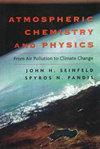中国西南地区城市 PM2.5 的化学成分、来源和形成机制:2023 年初的案例研究
IF 5.2
1区 地球科学
Q1 ENVIRONMENTAL SCIENCES
引用次数: 0
摘要
摘要尽管近年来空气质量有了明显改善,但四川盆地冬季仍面临频繁的灰霾污染,而严重灰霾形成的原因尚未得到充分研究。本研究通过对四川盆地特大城市成都 2023 年初典型污染时段 PM2.5(即空气动力学直径小于 2.5 µm 的颗粒物)的化学成分进行了总量化学分析和单颗粒物分析,并分析了 PM2.5 的污染来源和形成机理。研究期间 PM2.5 的平均质量浓度为 95.6 ± 28.7 µg m-3。有机物(OM)是含量最高的成分(35.3%),其次是硝酸盐(22.0%)、硫酸盐(9.2%)和铵(7.8%)。气溶胶颗粒可分为五类,即矿物颗粒、OM 颗粒、二次无机气溶胶颗粒、烟尘颗粒和飞灰/金属颗粒,其中大部分处于内部混合状态。整个观测时段可分为两个非污染时段(NP-1 和 NP-2)和两个灰霾时段(Haze-1 和 Haze-2)。随着污染的演变,总量化学分析和单颗粒物分析表现出相似的特征,表明灰霾-1 主要由与化石燃料燃烧相关的污染物引起,尤其是本地移动源;而灰霾-2 则是由快速增长的二次污染物引发的,主要来自区域传输。PM2.5 的来源包括扬尘(8.5%)、生物质燃烧(3.5%)、燃煤(15.4%)、工业过程(6.5%)、车辆排放(25.6%)和二次污染源(40.5%)。气象研究和预报模式与化学(WRF-Chem)模式结果分析表明,本地污染源和区域传输对成都污染的平均贡献率相同(50% 对 50%)。此外,不同时期的污染源构成和 WRF-Chem 模拟结果也证实了我们对两次雾霾事件形成机制的分析。这项研究证实,成都的PM2.5仍需进一步大幅降低,未来需要更有效的地方减排政策或区域大气污染联防联控政策。本文章由计算机程序翻译,如有差异,请以英文原文为准。
Chemical composition, sources and formation mechanism of urban PM2.5 in Southwest China: a case study at the beginning of 2023
Abstract. Despite significant improvements in air quality in recent years, the Sichuan Basin (SCB) is still facing frequent haze pollution in winter, and the causes of severe haze formation have not yet been fully investigated. In this study, the chemical components of PM2.5 (i.e., particulate matter with an aerodynamic diameter of less than 2.5 µm) in a typical pollution period at the beginning of 2023 in Chengdu, a megacity in the SCB, were characterized by bulk-chemical and single-particle analysis, and the PM2.5 sources and formation mechanism of pollution were analyzed. The average mass concentration of PM2.5 during the study period was 95.6 ± 28.7 µg m−3. Organic matter (OM) was the most abundant component (35.3 %), followed by nitrate (22.0 %), sulfate (9.2 %) and ammonium (7.8 %). The individual aerosol particles were classified into five categories, i.e., mineral, OM, secondary inorganic aerosol (SIA), soot and fly ash/metal particles, and most of them were in the state of being internally mixed. The entire observation period could be divided into two non-pollution periods (NP-1 and NP-2) and two haze periods (Haze-1 and Haze-2). With the evolution of pollution, the bulk-chemical and single-particle analysis exhibited similar characteristics, suggesting that Haze-1 was mainly caused by pollutants related to fossil fuel combustion, especially local mobile sources, while Haze-2 was triggered by the rapidly increasing secondary pollutants, which mainly came from regional transmission. The PM2.5 sources included dust (8.5 %), biomass burning (3.5 %), coal combustion (15.4 %), industrial processes (6.5 %), vehicular emissions (25.6 %) and secondary sources (40.5 %). Analysis of Weather Research and Forecasting model with Chemistry (WRF-Chem) model results showed that the average contributions of local sources and regional transmission to pollution in Chengdu were the same (50 % vs. 50 %). In addition, the source composition and WRF-Chem simulation results in different periods confirmed our analysis of the formation mechanisms of the two haze events. This study confirms that further significant reductions in PM2.5 in Chengdu are still needed, and more effective policies for local emission reduction or joint prevention and control of regional air pollution will be necessary in the future.
求助全文
通过发布文献求助,成功后即可免费获取论文全文。
去求助
来源期刊

Atmospheric Chemistry and Physics
地学-气象与大气科学
CiteScore
10.70
自引率
20.60%
发文量
702
审稿时长
6 months
期刊介绍:
Atmospheric Chemistry and Physics (ACP) is a not-for-profit international scientific journal dedicated to the publication and public discussion of high-quality studies investigating the Earth''s atmosphere and the underlying chemical and physical processes. It covers the altitude range from the land and ocean surface up to the turbopause, including the troposphere, stratosphere, and mesosphere.
The main subject areas comprise atmospheric modelling, field measurements, remote sensing, and laboratory studies of gases, aerosols, clouds and precipitation, isotopes, radiation, dynamics, biosphere interactions, and hydrosphere interactions. The journal scope is focused on studies with general implications for atmospheric science rather than investigations that are primarily of local or technical interest.
 求助内容:
求助内容: 应助结果提醒方式:
应助结果提醒方式:


